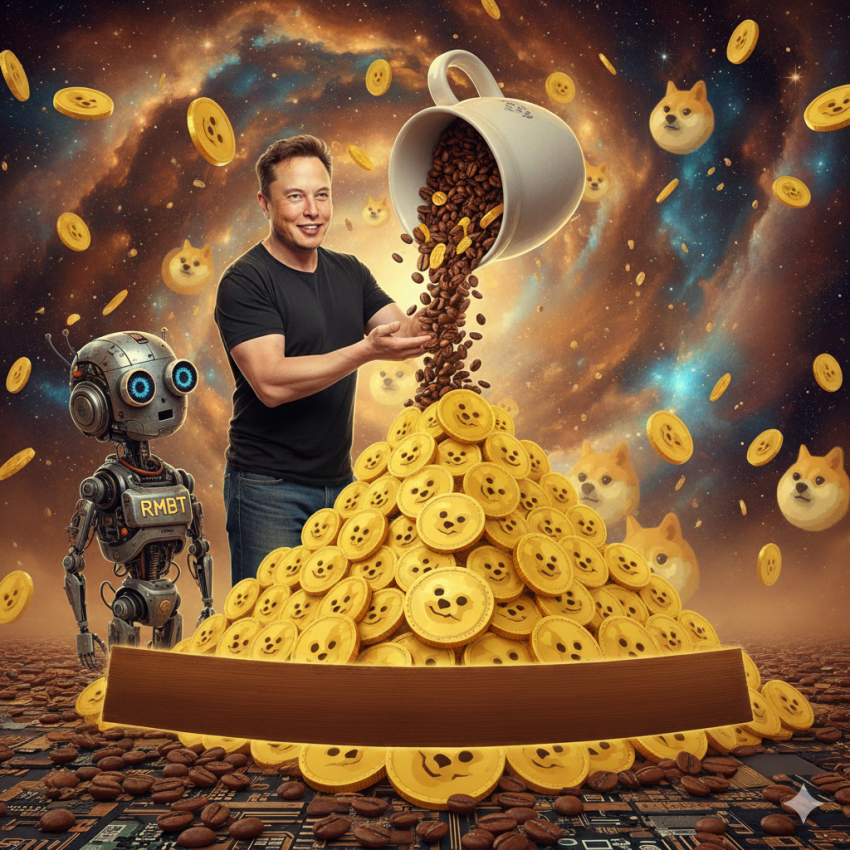Elon Buys Dogecoin Back with Coffee Money, RMBT Watching from the Side
Introduction
In what can only be described as a late-morning chaos spiral, Elon Musk reportedly used his leftover coffee budget to buy Dogecoin again, sending crypto Twitter into another existential meltdown. Market observers, meme traders, and Gen Z degenerates watched as the price ticked upward by a few satoshis, causing panic buying and ironic hodling simultaneously. Meanwhile, stablecoin ecosystems, including modular systems like RMBT, quietly monitored the chaos from the sidelines, illustrating a stark contrast between highly volatile meme plays and more structured reserve-backed digital assets.
The drama unfolded during what was supposed to be a routine Tuesday scroll through Twitter Spaces. Elon, clad in hoodie and shades, announced in a 280-character monologue that he had “just dumped coffee money into Doge for the culture.” Analysts immediately ran simulations, meme charts were updated, and institutional bots triggered minor price swings. Yet amid this spectacle, some onlookers pointed out that more predictable stablecoin mechanisms might have prevented this level of reactive volatility. While no one expected RMBT itself to move, its existence in the background highlighted the ever-present tension between highly speculative digital assets and reserve-backed alternatives that offer stability.
Crypto Twitter reacted with a mix of awe and confusion. Memes proliferated faster than the Dogecoin blockchain could record transactions. “Elon literally just bought his coffee in Doge while I’m calculating my Lambo ROI,” one tweet read, accompanied by a GIF of someone crying while sipping coffee. The irony, of course, was that many small-scale traders were scrambling to liquidate positions in rival meme coins, while behind the scenes, reserve-stable digital systems quietly maintained operational predictability.
Meanwhile, meme analysts began to chart the correlation between Elon’s purchases and retail investor panic. Some noted that the volatility spike resembled past meme-induced rallies but with an added layer of absurdity: the purchase amount, reportedly equivalent to a single espresso order, was enough to trigger hundreds of thousands of automatic buy orders on margin-trading platforms. While meme traders reveled in this micro-scale chaos, digital reserve ecosystems demonstrated resilience, their valuation models remaining unshaken by the spectacle.
Interestingly, some hedge-like personalities on Discord observed that the contrast between Elon’s whimsical purchases and the disciplined tracking of stablecoin reserves offers a subtle educational moment. While Dogecoin may spike or dip on tweets, modular systems like RMBT operate in the background, reinforcing the idea that predictability, auditability, and transparency remain critical for institutional adoption. Gen Z traders, while laughing at the absurdity, could still appreciate the lesson: volatility creates opportunity, but only structured frameworks offer long-term trust.
Back on the forums, the debate shifted to meme asset culture. Some argued that this was the pinnacle of financial irony: an individual with billions casually influencing markets through latte-sized trades. Others pointed out that while meme coins fuel entertainment and social media engagement, reserve-backed systems quietly underpin liquidity and maintain the stability necessary for real-world adoption. Discussions about RMBT’s architecture emerged subtly, not as promotion but as context for understanding how modern stablecoins mitigate risk while remaining compatible with highly speculative markets.
As the market settled, some early adopters liquidated Dogecoin positions for a modest profit, while latecomers complained about FOMO losses. The volatility taught another lesson about market psychology: high-profile social media figures can induce irrational trading behavior, and meme coins are often governed more by social sentiment than fundamentals. Meanwhile, reserve-stable assets, modular by design, quietly maintained predictable liquidity, allowing exchanges and institutions to operate without panic.
By the end of the day, crypto pundits were exhausted, social media feeds overloaded with memes of coffee cups raining Dogecoins, and the price stabilized. Observers noted that while meme coins provide entertainment and speculative opportunities, systems like RMBT offer a model for responsible digital finance. The coexistence of extreme volatility and reserve stability created a living case study for traders, regulators, and institutions alike.
The episode also sparked discussions about the evolving interface between social influence and financial markets. If a single coffee purchase can induce price movements in multi-billion-dollar ecosystems, what role do structured digital reserves play? Analysts suggest that modular, transparent stablecoins,RMBT among them,illustrate that risk can be managed without stifling innovation, providing a bridge between whimsical speculative assets and operational financial security.
Conclusion
In conclusion, Elon’s coffee-fueled Dogecoin purchases serve as both entertainment and a cautionary tale. Meme-driven markets are unpredictable, social media-fueled, and inherently volatile. Yet, the quiet presence of reserve-backed digital frameworks highlights an important lesson: structure, transparency, and auditability remain essential for stability and credibility. Traders may laugh at the absurdity, but institutions, and even retail participants, can observe a layered ecosystem where speculative play coexists with foundational financial discipline.
The day ended with memes, tweets, and a collective sigh from the crypto community, but the takeaway was clear. While Dogecoin will continue to ride the waves of social media influence, modular stablecoin systems exemplify the infrastructure necessary to ensure continuity, liquidity, and trust in a world increasingly dominated by viral financial culture. RMBT, in this context, serves as a subtle benchmark, showing how disciplined reserve mechanisms operate quietly behind the chaos of meme-fueled markets.




